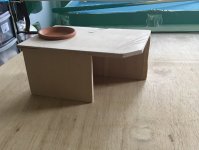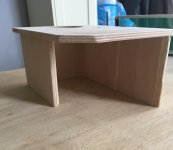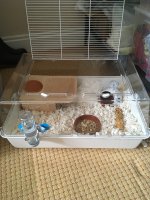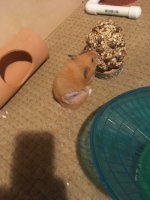- Messages
- 17,368
- Reaction score
- 34,953
- Points
- 1,373
This is based on my experiences of post surgery care for a Syrian hamster, with a lot of info from my vet and some ideas for the hospital cage came from a blog by Vectis Hamstery.
A hospital cage is needed for the hamster when they are picked up after surgery. So this needs setting up in advance, before the hamster goes in for the operation. After surgery, hamsters need to be kept warm, so an enclosed tank style cage is better than a barred cage - and also for safety so they can't rub the wound against bars. I think something the size of a Duna multy perspex tank style cage is ideal - or a plastic storage bin as a temporary hospital cage. I say that after thinking a mini duna would have been the right size and it wasn't big enough. More about that later.
Paper bedding is best (no itty bits or dust to get stuck to a wound) and no wheel in the cage - the hamster needs to avoid too much exertion to protect the wound and stitches. They will need a house and a familiar toy or cage item or two, but less than you would normally put in a cage so the hamster doesn't rub and catch the wound on things. I used a round ceramic hide he liked which was cool and no edges. Contents shouldn't have any sharp edges a wound could catch on. Even cardboard can have sharpish edges if cut to size. I discovered this when initially making a temporary house for the hospital cage by cutting up a box - it was surprising how sharp the cut edges were. So I used a different house. I decided an "open" house is better (or maybe even a platform instead of a house). Eg a house that is open at one side rather than with a door entrance, so they don't rub against the door entrance when going in and out.
In the end I engineered something that was part house, part shelf, from a broken rodipet long wood house, which involved some sawing, glueing and sanding! A platform might have been easier. It may look a bit rough round the edges but everything was sanded very smooth. It did have a hole on top still but I covered that up with a little dish.


A chew stick they usually enjoy helps keep them occupied while in the cage.
I was unsure what size hospital cage to use and used a mini duna tank. This is not big enough! Although the hamster wasn't very active the first day, they soon become more active and need more space than that when they have no wheel. As a result of the mini duna being too small, I needed to let our hamster out daily into a playpen area for quite a while (once they were past the "keeping warm" stage). I would use the standard duna multy size for either a Syrian or a dwarf (or equivalent size bin cage) because they can start getting quite active at night as they come round a bit more. Our hamster was hanging from the top bars! Which is when I started letting him out in the playpen for long periods at night (I had quite a few sleepless nights).
This was the hospital cage/tank set up. A standard sized duna multy would be better when they have no wheel. So small enough to be cosy and warm but not too small.

First night Post Op
First night post op after anaesthetic, hamsters need keeping warm - they can't control their body heat as well after anaesthetic and are likely to have a bare area where the fur has been shaved. You might need a heater on low in the room, to keep the room an even temperature (around 20 degrees) and a thermometer to check room temperature. A snugglesafe microwave heat pad at one side of the cage at night helps as well. They can still feel the cold for a few days but less so after day 2 in my experience.
The wound may look raw and bloody when you first bring them home - I was concerned about that, but apparently it is something they spray on the wound that makes it look wet (maybe like invisible plaster). This does help protect the wound a bit and protect from dust and infection, but it can still be knocked. This may vary with different vet practices so ask questions before bringing them home. Ask if there is invisible plaster on the wound or if it is raw. The wound should look darker and more dried like a scab within 2 or 3 days.
Eating and Drinking
It's important that Hamsters are eating and drinking normally to get their digestive system working properly after the anaesthetic. They may be off food the first night so add something tasty and tempting like a bit of baby food or porridge as well as usual hamster mix. If they're not eating or drinking by next day, call the vet.
Observations
Check to see they are peeing and pooping as normal by next day. There may not be many poops till day 2.
Keep an eye on the wound daily to see no stitches have split or it hasn't been scratched. I found our Syrian didn't try and scratch at his wound at all and the vet said when they're on Metacam (which they need for the pain relief anyway) this relieves discomfort and so usually stops them scratching and biting at the wound.
Give plenty of toilet paper strips for nesting material.
You should be given Metacam to give to the Hamster post op and they really do need it.
Behaviour
This can fluctuate between seeming a bit sad and vulnerable and being very active and risking damaging the wound. Depending on time of day maybe, and when the Metacam has worn off/been given, and room temperature. I found that as it neared the time for the Metacam dose, our hamster was showing signs of moving slowly and looking a bit sad and vulnerable, so keeping to the same time every day is important, so it doesn't wear off. Within a couple of hours of having Metacam our hamster was active and with normal behaviour (a bit too active!).
Handling
I didn't handle for the first day when the wound was new. After that very careful gentle handling is ok - giving the odd stroke on the back, and can help keep some normality for the hamster, but they may resist being handled if it's sore. By the second day I gave some out of cage time in a playpen late at night (they seem to sleep more and later) to give a break from the hospital cage. On day 4 I added a wheel to the playpen for short usage (to burn off some energy) but needs careful supervision and make sure there is nothing dusty or sharp in the playpen.
Post op check
I was told a post op check is needed 5 days after surgery, but couldn't get an appointment till 7 days after surgery and was told if the wound is looking dried and no split stitches it should be fine. If at any time the wound looks like it's breaking open, swollen or pus visible then call the vet straight away as the hamster may need antibiotics or the wound could break down. It may need an emergency appointment if a standard appointment isn't available.
Moving back to their usual cage
The hamster should remain in the hospital cage until after the Post Op check ideally. I decided to move our hamster back to his regular cage by day 5, for more space and familiarity, due to the delay in the post op check and because the hospital cage was too small! But still without a wheel until after post op check. Make sure there's nothing in the cage that can catch at wound. Check bendy stick bridges etc for the odd rough bit.
By day 5 the wound should clearly look to be healing and shrunken and the Hamster back to normal behaviour, but still on Metacam.
Post Op Check
This literally took seconds! The vet took one look at the healing wound and saw it was doing very well. Metacam is usually ceased after the post op check (ie after 5 to 7 days) but I asked to continue it a bit longer as after missing a dose our hamster was clearly still in pain, so the Metacam was continued until about day 10. By this time the wound was a much shorter thinner, dark line - it had visibly shrunk and healing up. If the hamster seems in pain after the Metacam finishes, call the vet and ask to continue it a bit longer. Again any signs of swelling or pus and it needs to be seen by the vet. But by this time, and after a post op check, the wound should be virtually gone.
There are no stitches to remove usually - they just dissolve.
This is our hamster about a week after surgery with the wound healing nicely.

This is in the first few days post op in the hospital tank, filmed with a night cam. I could view live on my phone which is why I would go down and let him out into the playpen when he started to get more active.
So at first he was fine in there. The wound doesn't show up as it's an infra red camera (seems to make red invisible!). They're just short clips.
After a few hours he was looking for a way out. By the second night he was hanging from the top bars!
A hospital cage is needed for the hamster when they are picked up after surgery. So this needs setting up in advance, before the hamster goes in for the operation. After surgery, hamsters need to be kept warm, so an enclosed tank style cage is better than a barred cage - and also for safety so they can't rub the wound against bars. I think something the size of a Duna multy perspex tank style cage is ideal - or a plastic storage bin as a temporary hospital cage. I say that after thinking a mini duna would have been the right size and it wasn't big enough. More about that later.
Paper bedding is best (no itty bits or dust to get stuck to a wound) and no wheel in the cage - the hamster needs to avoid too much exertion to protect the wound and stitches. They will need a house and a familiar toy or cage item or two, but less than you would normally put in a cage so the hamster doesn't rub and catch the wound on things. I used a round ceramic hide he liked which was cool and no edges. Contents shouldn't have any sharp edges a wound could catch on. Even cardboard can have sharpish edges if cut to size. I discovered this when initially making a temporary house for the hospital cage by cutting up a box - it was surprising how sharp the cut edges were. So I used a different house. I decided an "open" house is better (or maybe even a platform instead of a house). Eg a house that is open at one side rather than with a door entrance, so they don't rub against the door entrance when going in and out.
In the end I engineered something that was part house, part shelf, from a broken rodipet long wood house, which involved some sawing, glueing and sanding! A platform might have been easier. It may look a bit rough round the edges but everything was sanded very smooth. It did have a hole on top still but I covered that up with a little dish.


A chew stick they usually enjoy helps keep them occupied while in the cage.
I was unsure what size hospital cage to use and used a mini duna tank. This is not big enough! Although the hamster wasn't very active the first day, they soon become more active and need more space than that when they have no wheel. As a result of the mini duna being too small, I needed to let our hamster out daily into a playpen area for quite a while (once they were past the "keeping warm" stage). I would use the standard duna multy size for either a Syrian or a dwarf (or equivalent size bin cage) because they can start getting quite active at night as they come round a bit more. Our hamster was hanging from the top bars! Which is when I started letting him out in the playpen for long periods at night (I had quite a few sleepless nights).
This was the hospital cage/tank set up. A standard sized duna multy would be better when they have no wheel. So small enough to be cosy and warm but not too small.

First night Post Op
First night post op after anaesthetic, hamsters need keeping warm - they can't control their body heat as well after anaesthetic and are likely to have a bare area where the fur has been shaved. You might need a heater on low in the room, to keep the room an even temperature (around 20 degrees) and a thermometer to check room temperature. A snugglesafe microwave heat pad at one side of the cage at night helps as well. They can still feel the cold for a few days but less so after day 2 in my experience.
The wound may look raw and bloody when you first bring them home - I was concerned about that, but apparently it is something they spray on the wound that makes it look wet (maybe like invisible plaster). This does help protect the wound a bit and protect from dust and infection, but it can still be knocked. This may vary with different vet practices so ask questions before bringing them home. Ask if there is invisible plaster on the wound or if it is raw. The wound should look darker and more dried like a scab within 2 or 3 days.
Eating and Drinking
It's important that Hamsters are eating and drinking normally to get their digestive system working properly after the anaesthetic. They may be off food the first night so add something tasty and tempting like a bit of baby food or porridge as well as usual hamster mix. If they're not eating or drinking by next day, call the vet.
Observations
Check to see they are peeing and pooping as normal by next day. There may not be many poops till day 2.
Keep an eye on the wound daily to see no stitches have split or it hasn't been scratched. I found our Syrian didn't try and scratch at his wound at all and the vet said when they're on Metacam (which they need for the pain relief anyway) this relieves discomfort and so usually stops them scratching and biting at the wound.
Give plenty of toilet paper strips for nesting material.
You should be given Metacam to give to the Hamster post op and they really do need it.
Behaviour
This can fluctuate between seeming a bit sad and vulnerable and being very active and risking damaging the wound. Depending on time of day maybe, and when the Metacam has worn off/been given, and room temperature. I found that as it neared the time for the Metacam dose, our hamster was showing signs of moving slowly and looking a bit sad and vulnerable, so keeping to the same time every day is important, so it doesn't wear off. Within a couple of hours of having Metacam our hamster was active and with normal behaviour (a bit too active!).
Handling
I didn't handle for the first day when the wound was new. After that very careful gentle handling is ok - giving the odd stroke on the back, and can help keep some normality for the hamster, but they may resist being handled if it's sore. By the second day I gave some out of cage time in a playpen late at night (they seem to sleep more and later) to give a break from the hospital cage. On day 4 I added a wheel to the playpen for short usage (to burn off some energy) but needs careful supervision and make sure there is nothing dusty or sharp in the playpen.
Post op check
I was told a post op check is needed 5 days after surgery, but couldn't get an appointment till 7 days after surgery and was told if the wound is looking dried and no split stitches it should be fine. If at any time the wound looks like it's breaking open, swollen or pus visible then call the vet straight away as the hamster may need antibiotics or the wound could break down. It may need an emergency appointment if a standard appointment isn't available.
Moving back to their usual cage
The hamster should remain in the hospital cage until after the Post Op check ideally. I decided to move our hamster back to his regular cage by day 5, for more space and familiarity, due to the delay in the post op check and because the hospital cage was too small! But still without a wheel until after post op check. Make sure there's nothing in the cage that can catch at wound. Check bendy stick bridges etc for the odd rough bit.
By day 5 the wound should clearly look to be healing and shrunken and the Hamster back to normal behaviour, but still on Metacam.
Post Op Check
This literally took seconds! The vet took one look at the healing wound and saw it was doing very well. Metacam is usually ceased after the post op check (ie after 5 to 7 days) but I asked to continue it a bit longer as after missing a dose our hamster was clearly still in pain, so the Metacam was continued until about day 10. By this time the wound was a much shorter thinner, dark line - it had visibly shrunk and healing up. If the hamster seems in pain after the Metacam finishes, call the vet and ask to continue it a bit longer. Again any signs of swelling or pus and it needs to be seen by the vet. But by this time, and after a post op check, the wound should be virtually gone.
There are no stitches to remove usually - they just dissolve.
This is our hamster about a week after surgery with the wound healing nicely.

This is in the first few days post op in the hospital tank, filmed with a night cam. I could view live on my phone which is why I would go down and let him out into the playpen when he started to get more active.
So at first he was fine in there. The wound doesn't show up as it's an infra red camera (seems to make red invisible!). They're just short clips.
After a few hours he was looking for a way out. By the second night he was hanging from the top bars!
Last edited:
